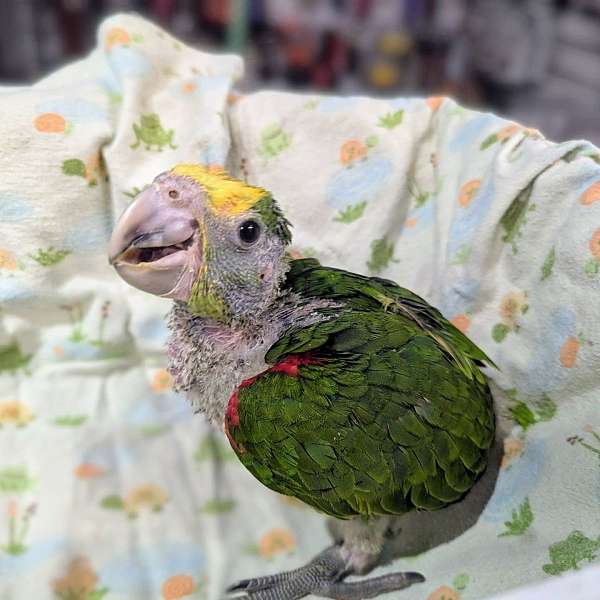- Characteristic
- Companion, Cute, Handfed, Pet, Rare, Singing, Talking, Tame
Additional Comments
The double yellow-headed Amazon parrot, or yellow-headed parrot, is among the most popular companion Amazons, probably due to its striking coloring and its ability to amass a substantial vocabulary. These birds are especially talented in learning opera and other types of singing, making them charming companions. These 14 to 16 inch active birds are recognizable by the generous amount of yellow over the head, with flecks of yellow extending to the back and neck and yellow feathers on the legs.... (read more) The shoulders are red and the rest of the body is deep green. The ring around the eye is white and the beak is horn colored. Immature birds are primarily green with a little yellow above the beak and slight red markings on the shoulders.
Care Guide and Recommendations
Habitat
A Roomy Cage. Non-toxic powder coating Metal one (minimum size recommended 24″ x 24″ x 60″ or biggest possible.
Humid and warm environment. (Automatic / manual misting / showering regularly { specially made shower & window perches are quite helpful}.
A combination of tap water shower and use of recommended bird bath sprays with gland oil helps relieve / eliminate minor skin irritation and itchiness on the body.
Bedding (Preferable: Fresh and Comfy Recycled Paper Bedding / aspen shaving / corn cob)
Toys (They love to chew, therefore, providing a few toys helps in catering to a healthy lifestyle for the pet!). A combination of 5-7 (2-3 hard & 3-4 soft chewable {food grade coloured toys).
A combination of sand (nail & beak filing) and regular perches inside the cage. (Preferably Java / dragon wood).
Installation of Java tree on top of the cage with extra food bowls (steel ones) and a couple of hanging toys.
A minimum of 3 steel containers.
Food Bowl (Usually included in Cages). Mixture of Tropican (pallets size minimum 4 mm) and Tropimix Large parrot.
Mineral and Vitamin Bowl. (Clay Cal and Prime Vitamin Amino Acid Mixture). Moist food including Fruits, Veggies etc. to be dropped / served in this bowl.
Water bowl. regular tap cold water (put some anti chlorine drops). Water to be changed at least once a day or every time the bird dropping is seen.
Hideout. Hammock / Tent for them to feel protected. Unwanted exposure stresses the bird out.
UVA / UVB lighting has proved to be very beneficial for these birds. It helps processing the calcium in captivity and also help controlling the temperature in cage. Metal dome is to be used and to be placed on top of the cage.
For more information visit our Instagram @GardenStatePetCenter or visit our website visit our website
